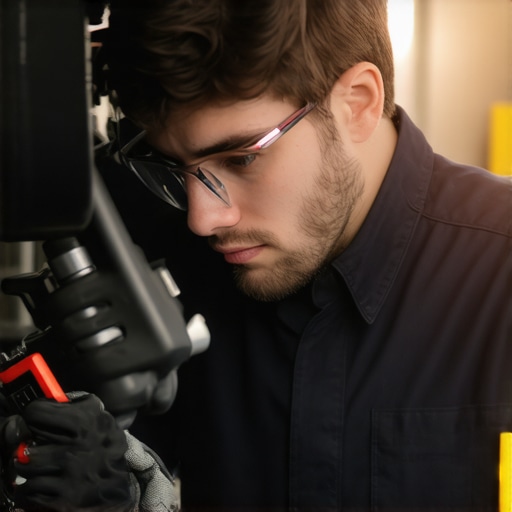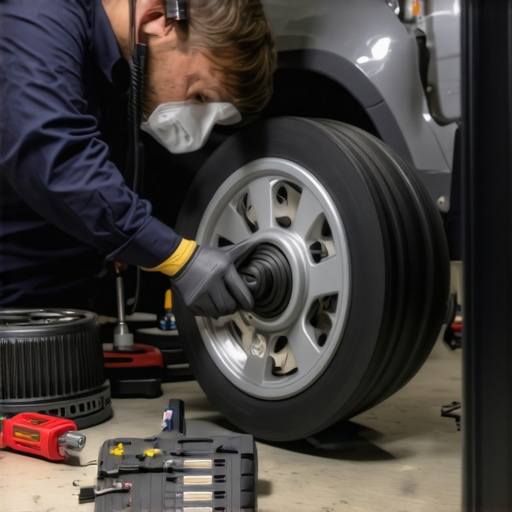My Journey into Auto Repair: Why I Started Paying Attention to Car Maintenance
Last year, I found myself stranded on the side of the road due to a sudden breakdown. That experience was a wake-up call, prompting me to learn more about auto repair tips that could save me time and money. From that moment, I became a more attentive car owner, eager to understand the essentials of vehicle maintenance and repair.
Essential Auto Repair Tips for 2024: What I’ve Learned Along the Way
How do I keep my car in top condition without breaking the bank?
One of the most valuable lessons I learned is the importance of regular inspections and preventive maintenance. This includes routine oil changes, checking tire pressure, and inspecting brake systems. For example, I now schedule a comprehensive auto check-up at least twice a year, which helps catch issues early and saves me from costly repairs down the line. For trusted guidance, I often refer to trusted resources like CollisionRenew’s expert tips.
Why Brake Care Should Be a Priority in 2024
Brakes are the backbone of vehicle safety. I’ve learned that neglecting brake maintenance can lead to dangerous situations on the road. That’s why I prioritize regular brake inspections and services, especially before long trips. For detailed strategies, I check out CollisionRenew’s brake service tips. Maintaining effective brakes is crucial for safe driving and peace of mind.
What Are the Best Auto Repair Practices I Adopted?
Beyond routine maintenance, I’ve adopted some best practices that have made a real difference. For instance, I keep a maintenance log to track service dates and repairs. I also ensure that I use high-quality auto parts and trusted service providers. These habits not only extend my vehicle’s lifespan but also improve its performance. If you’re curious about comprehensive car care, I recommend exploring CollisionRenew’s auto repair solutions.
Is DIY Auto Repair a Good Idea?
Sometimes, I get tempted to fix minor issues myself. While DIY projects can be rewarding, I’ve learned that some repairs, like transmission work or collision repairs, are best left to professionals. For example, I once attempted to replace brake pads myself, but realized I lacked the expertise, which could compromise safety. It’s always wise to consult with certified technicians to ensure quality and safety. For expert assistance, I turn to CollisionRenew’s professional repair services.
What’s the One Auto Repair Tip I Wish I Knew Earlier?
Honestly, I wish I had started regular maintenance sooner. The difference it makes in vehicle reliability and safety is remarkable. Consistent care prevents unexpected breakdowns and keeps my car running smoothly, which boosts my confidence on the road. If you’re interested in more tips, don’t hesitate to explore the vast resources available online or consult your local auto repair experts.
Feeling inspired to give your car the care it deserves? Share your own auto repair experiences or ask questions in the comments below. Remember, proactive maintenance is the key to safe and reliable driving in 2024!
Understanding the Nuances of Brake System Diagnostics for Expert-Level Maintenance
As automotive enthusiasts and professionals, we know that the brake system is a complex interplay of components that require precise diagnostics. Beyond visual inspections, advanced tools like brake fluid testers, ultrasonic sensors, and computer diagnostics are essential for uncovering hidden issues such as caliper sticking, rotor warping, or master cylinder deterioration. Regularly utilizing these diagnostic techniques helps prevent catastrophic failures and extends the lifespan of your brake components.
How Do I Prioritize Brake Service in My Overall Vehicle Maintenance Plan?
Integrating brake maintenance into your comprehensive auto care routine ensures optimal safety. I recommend scheduling brake inspections every 10,000 to 15,000 miles, especially before winter or long trips. This proactive approach aligns with insights from CollisionRenew’s expert brake service strategies, emphasizing that early intervention can save lives and reduce repair costs. Remember, a well-maintained brake system is not just about safety but also about maintaining vehicle performance and resale value.
What Are the Latest Innovations in Brake Technology That Experts Should Know?
In recent years, advancements such as ceramic brake pads, regenerative braking systems, and electronically controlled ABS have revolutionized safety and efficiency. Ceramic pads offer quieter operation and longer life, while regenerative brakes, common in hybrid and electric vehicles, recover energy and reduce wear. Staying informed about these innovations allows professionals to recommend the best solutions tailored to each vehicle’s needs. For a deep dive into these technologies, consult authoritative sources like CollisionRenew’s comprehensive auto repair tips.
Image illustrating an advanced brake system diagnostic process, highlighting technicians using specialized tools for precise assessment.
What Could Be the Consequences of Ignoring Brake Maintenance Over Time?
Neglecting brake care can lead to severe safety hazards, including brake fade, reduced stopping power, or complete failure. Over time, worn brake pads and warped rotors can cause vibrations, noise, and increased stopping distances—factors that dramatically increase the risk of accidents. Additionally, untreated brake issues can damage other components, like wheel bearings and suspension parts, leading to costly repairs. Staying ahead with regular inspections and timely replacements is essential, and resources like CollisionRenew’s professional brake services are invaluable in this pursuit.
Feeling inspired to elevate your brake maintenance routine? Share your experiences or ask questions in the comments below. Remember, expert knowledge combined with regular care is the key to safer, more reliable driving in 2024!
What Are the Nuances of Diagnosing Brake System Issues That Experts Understand Deeply?
For me, understanding the subtle nuances of brake diagnostics was a game-changer. It’s one thing to visually inspect brake pads and rotors, but the real mastery lies in interpreting data from advanced tools like ultrasonic sensors and brake fluid testers. These devices reveal hidden problems—like caliper sticking or rotor warping—that aren’t immediately visible but critically impact safety and performance. I recall a time when a routine inspection uncovered uneven rotor wear, which, if ignored, could have led to dangerous vibrations or brake failure. This experience underscored how precision diagnostics are essential, especially as vehicles incorporate more sophisticated braking technology such as regenerative systems and electronically controlled ABS, which require a deeper understanding of their operational intricacies. By employing these advanced diagnostic techniques, I was able to recommend targeted repairs that extended the lifespan of brake components and ensured safe driving conditions. For professionals aiming to elevate their expertise, staying abreast of the latest diagnostic tools and techniques is vital—resources like CollisionRenew’s expert tips provide invaluable insights into mastering these advanced assessments.
How Do I Prioritize Brake Service in My Overall Vehicle Maintenance Routine?
Integrating brake maintenance into my regular auto care routine has proven to be a strategic approach. I schedule comprehensive brake inspections every 10,000 to 15,000 miles, especially before winter or long trips, aligning with industry recommendations and expert advice from CollisionRenew’s maintenance tips. This proactive scheduling isn’t just about safety; it’s about maintaining vehicle performance and resale value. To deepen this practice, I keep a detailed maintenance log, noting inspection dates, findings, and repairs. This habit helps me identify patterns—such as recurring brake pad wear—so I can make timely decisions and avoid unexpected breakdowns. Additionally, I’ve learned to communicate effectively with technicians, understanding their diagnostic reports and repair recommendations. This collaborative approach ensures I prioritize critical repairs without unnecessary expenses, making my vehicle safer and more reliable over the long term. For those looking to refine their routine, exploring comprehensive auto care resources like CollisionRenew’s auto repair solutions can provide valuable guidance.
What Are the Latest Innovations in Brake Technology That Might Be Relevant for Me?
Staying informed about emerging brake technologies has significantly expanded my understanding of vehicle safety. Innovations like ceramic brake pads, regenerative braking, and electronically controlled ABS have transformed how I think about maintenance and repair. For example, ceramic pads offer quieter operation and longer lifespan, which reduces replacements and enhances driving comfort. Regenerative braking, prevalent in hybrid and electric vehicles, not only recovers energy but also reduces brake wear—something I’ve noticed extends service intervals. Understanding these advancements helps me advise vehicle owners on the most suitable solutions, whether they’re upgrading parts or diagnosing issues. Keeping up with these trends requires continuous learning, often through reputable sources like CollisionRenew’s comprehensive tips. Embracing these innovations allows me to provide more precise recommendations, ensuring safety and efficiency are always at the forefront of my service approach.
Image illustrating an advanced brake system diagnostic process, highlighting technicians using specialized tools for precise assessment.
How Can I Better Understand the Complex Interplay of Brake Components to Improve Diagnostics?
Gaining a deeper understanding of the complex interplay between brake components—such as calipers, rotors, pads, and sensors—has been instrumental in my development as a technician. I’ve learned that issues often stem from subtle interactions: a sticking caliper can cause uneven pad wear, which in turn leads to rotor warping. Recognizing these connections requires not just technical knowledge but also critical thinking and experience. For example, a vibration during braking might seem straightforward, but by understanding the entire system’s dynamics, I can identify whether the root cause is a warped rotor, a malfunctioning sensor, or a hydraulic issue. This holistic view enhances diagnostic accuracy and repair quality. To deepen this expertise, I regularly consult advanced diagnostic guides and participate in training programs offered by leading industry associations. Sharing this knowledge with peers and clients helps cultivate a culture of safety and precision—something I’m passionate about. If you’re interested in expanding your diagnostic skills, resources like CollisionRenew’s professional insights are invaluable for continuous learning and mastery.
Deciphering the Subtle Interplay of Brake Components for Precision Repairs
Gaining an intricate understanding of how individual brake components interact has been transformative in my auto repair journey. The calipers, rotors, pads, and sensors form a delicate ecosystem where a minor imbalance can cascade into major safety issues. For instance, a caliper sticking slightly can cause uneven pad wear, leading to rotor warping—a subtlety that only becomes apparent through meticulous diagnostics. Recognizing these nuanced interactions allows me to pinpoint root causes with greater accuracy, reducing unnecessary part replacements and ensuring optimal safety.
What Advanced Diagnostic Techniques Can Uncover Hidden Brake System Issues?
Employing sophisticated tools like ultrasonic sensors and brake fluid testers has significantly refined my diagnostic process. Ultrasonic testing reveals irregularities in rotor thickness and surface imperfections that are invisible to the naked eye. Meanwhile, brake fluid testers assess the moisture content and boiling point, preventing issues like brake fade during high-demand situations. Integrating these technologies, along with computer diagnostics, provides a comprehensive view of the system’s health, enabling targeted repairs that extend component life and enhance safety. According to industry standards outlined by CollisionRenew’s expert insights, this multi-faceted approach is essential for high-level brake maintenance.
How Do I Incorporate Cutting-Edge Brake Technologies into Routine Maintenance?
Staying abreast of innovations like ceramic brake pads, regenerative braking, and electronically controlled ABS has expanded my toolkit for delivering superior service. Ceramic pads, with their quieter operation and extended lifespan, are increasingly becoming the standard recommendation for clients seeking durability and comfort. Regenerative braking systems, prevalent in hybrid and electric vehicles, not only recover energy but also reduce wear on traditional brake components. Understanding these advancements allows me to advise clients accurately and perform diagnostics that consider the latest developments. Continuous education through trusted resources like CollisionRenew’s comprehensive tips ensures I remain a trusted expert in this evolving field.
What Are the Critical Considerations When Diagnosing Modern Brake Systems?
Modern brake systems integrate electronic controls and sensors, making diagnostics more complex yet more precise. I focus on interpreting data from ABS sensors, brake pressure modulators, and electronic stability control modules. For example, a vehicle exhibiting pulsation during braking might have a warped rotor, but if the ABS warning light is activated, it indicates a sensor malfunction or control module issue. Advanced diagnostic software allows me to visualize real-time data streams and identify discrepancies that traditional methods might miss. This deep understanding ensures repairs are not just reactive but proactive, preventing future failures. For comprehensive insights, I consult resources like CollisionRenew’s diagnostic strategies.
How Can I Enhance Customer Trust Through Expert Brake Diagnostics?
Transparency and education are key. When I perform advanced diagnostics, I explain each step and the importance of early intervention to my clients. Demonstrating how sensors and software pinpoint issues builds confidence and encourages proactive maintenance. I also emphasize the safety benefits of modern brake systems and the importance of regular check-ups—this approach fosters long-term relationships and positions me as a trusted authority. Sharing case studies or success stories online can further establish credibility and attract discerning clients seeking high-level expertise. For more professional insights, I recommend exploring CollisionRenew’s expert repair solutions.
Ready to Deepen Your Brake Diagnostics Skills?
If you’re passionate about elevating your auto repair proficiency, I invite you to dive into these advanced diagnostic techniques and stay updated with the latest technological trends. Mastering the subtle nuances of brake system interactions not only improves safety but also differentiates you as a leading professional in the field. Share your experiences or ask questions below—let’s learn and grow together in this complex yet rewarding domain of automotive care.
Things I Wish I Knew Earlier (or You Might Find Surprising)
1. The Subtle Signs Are Often the Most Critical
In my early days of auto repair, I overlooked minor vibrations or squeaks, thinking they were trivial. Now, I realize these subtle signs can indicate serious underlying issues—like warped rotors or caliper problems—that, if caught early, save money and enhance safety.
2. Not All Brake Problems Are Visible
During inspections, I learned that some issues lurk beneath the surface, like moisture in brake fluid or sensor malfunctions, which require advanced diagnostic tools such as ultrasonic sensors or brake fluid testers. This insight changed how I approach diagnostics, making me more thorough.
3. Regular Maintenance Is a Game-Changer
Waiting until brakes squeal or fail is a mistake. Routine inspections every 10,000 to 15,000 miles, especially before winter or long trips, have helped me prevent emergencies. Trust me, proactive care beats reactive repairs anytime.
4. Modern Brake Technologies Are Evolving Fast
Innovations like ceramic pads, regenerative braking, and electronically controlled ABS are revolutionizing vehicle safety. Staying updated with these trends allows me to recommend the best solutions and perform diagnostics that incorporate the latest tech.
5. Deep System Understanding Elevates Diagnostics
Understanding how calipers, rotors, sensors, and hydraulic systems interact has been crucial. I’ve learned that a small sticking caliper can cause uneven wear, leading to bigger issues down the line. Mastering these interactions makes me a better mechanic.
6. Advanced Diagnostic Tools Are Essential
Tools like ultrasonic sensors and brake fluid testers reveal hidden problems invisible to the naked eye. They help me make precise repairs, extend component life, and ensure safety—something I highly recommend investing in or learning about.
Resources I’ve Come to Trust Over Time
- CollisionRenew’s Expert Tips: Their comprehensive guides on auto repair and brake diagnostics have been invaluable for staying current with industry standards.
- Automotive Service Association (ASA): A trusted resource for industry best practices and technical training, helping me refine my skills continually.
- SAE International: Their publications and standards deepen my understanding of automotive engineering and emerging technologies.
Parting Thoughts from My Perspective
Reflecting on my auto repair journey, I realize that embracing continuous learning, staying updated with the latest brake technologies, and understanding the nuanced interactions within brake systems have made all the difference. Regular inspections and advanced diagnostics not only improve safety but also build trust with clients. If this resonates with you, I’d love to hear your own experiences or insights. Sharing knowledge helps us all grow and ensures safer roads for everyone. Remember, proactive maintenance and a curious mind are your best tools in this evolving field—so keep learning and stay safe out there!



